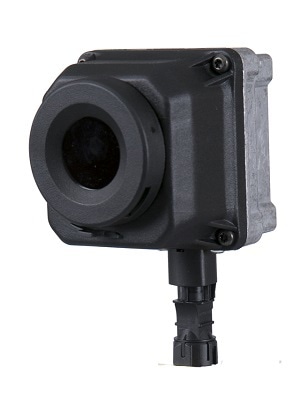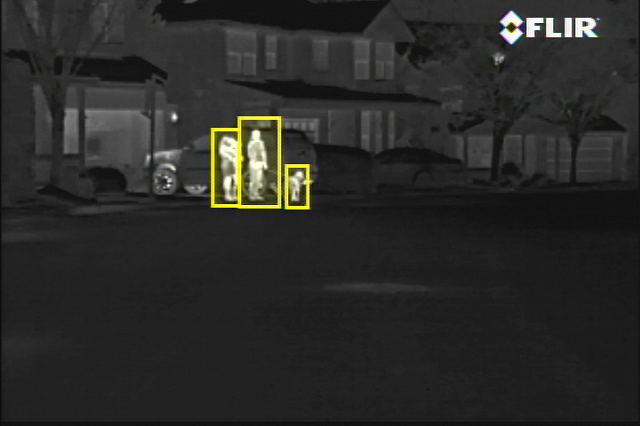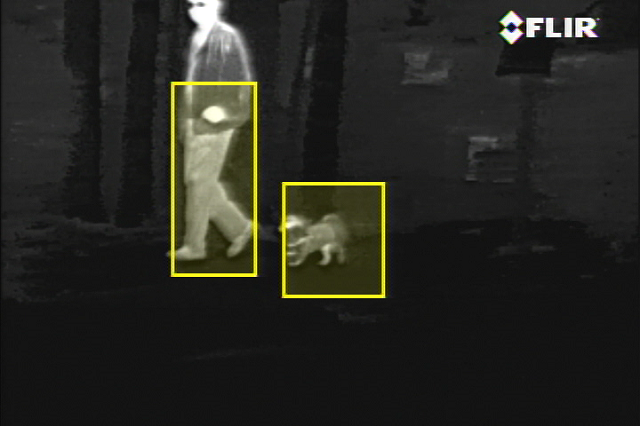Can you give us a brief overview of the PathFindIR Market?
The PathFindIR Market is the aftermarket version of the OEM products that are incorporated—via Autoliv—into BMW, Audi, Daimler, and the recently announced Cadillac cars. The OEM-installed versions of the PathFindIR are fully integrated into the car, and provide the directional alert to vastly improve safety during night driving.

PathFindIR II
PathFindIR is the aftermarket version of the OEM solution. It has all the same key features such as Pedestrian and Animal detection, but since it is designed to be a generic version for all vehicles, it's not hooked up into the car’s CAN bus and therefore lacks some of the integrated OEM features—such as the BMW’s “Dynamic Light Spot” technology.
Due to the fact that the PathFindIR leverages the high-volume OEM solutions it is an extremely affordable, very rugged, automotive-tested product. Its functions are fully automatic and extremely simple to install. You can buy this system for your car and install with ease.
Autonomy is becoming more prevalent within the automotive sector. What advantages does the PathFindIR bring to automotive autonomy?
Let's talk about infrared in general for autonomous driving. Today, there are multiple systems that are used for autonomous driving. The one you hear about the most are the technologies on the Google pod cars. These use a LIDAR, which is a laser system that measures distance by illuminating a target with a laser and analyzing the reflected light. It’s extremely complex, very costly, and not very good in adverse weather conditions. Other autonomous driving solutions have not only included LIDAR, but also multiple Radar units, multiple visible cameras, as well as ultrasonic sensors. Many of these sensors are already present in vehicles for Automatic Cruise Control (ACC) and Lane Departure Warning (LDW) systems. As automakers look to the gamut of sensors that will be needed for Autonomous driving I believe infrared, with its ability to see in challenging lighting conditions, and more importantly as a way to accurately determine if the obstacle in question is alive, will also be required.
How does the PathFindIR help detect animals and people, and how is that improving road safety in those areas?
Infrared detects heat, and so it's not reliant on any illumination, be it from your headlights or from streetlights. It relies on the heat generated from animals or people. That's what enables the detection at a great distance, as it sees way past your headlights. When you're driving down the road at night, the environment is generally a lot cooler than in the daytime, but a person or animal radiates heat. This makes it very easy for infrared cameras to see these objects. The tricky part is to build the detection algorithms that say: that's really a person or that's really a deer or an elk. Once the algorithms are in place you not only have the sensitivity of the infrared, but the ability to identify a person or animal very easily.

How easy is it for automotive manufacturers to integrate the PathFindIR that you've developed?
FLIR works with Autoliv on the OEM solutions. FLIR brings the infrared know-how and Autoliv brings the detection algorithms alongside the OEM integration know-how. The OEM solutions are developed in conjunction with the car manufacturers and are plug-and-play from their factories.
For the PathFindIR aftermarket solution, the customer mounts the camera in the front of the car and basically puts power to it for video feed along with the pedestrian and animal alerts. There are aftermarket screens available to show the night vision feed, but because today’s cars often have screens built in for sat-nav, etc., several companies offer solutions that integrate the PathFindIR video stream into those existing integrated screens.
How effective is the senor in extreme weather and temperature conditions?
Infrared, like any technology, has limitations. Visible cameras don't work well at night and therefore do not give the driver the full situational awareness needed. Infrared cameras need to see a heat differential to optimize the detection algorithms, so are usually best used at night. In some areas of the world at night, if it's very, very hot, and the ambient temperature is the same temperature as a person, then it might be a little bit difficult to automatically detect a person, however most places are not like that. In some instances infrared can also be used very effectively in daylight. For example, there was an incident on a Florida turnpike where 70 vehicles got into a massive pile-up that blocked the road in both directions for 14 miles for nearly 36 hours. The cause was a nearby brush fire that spread smoke across the freeway. As smoke is simply transparent to infrared cameras (commonly used in firefighting units) it could have helped prevent such a situation.

Any technology has limitations, including infrared in foggy conditions or occasional hot climate zone conditions, but other than that, it's extremely good as far as night vision cameras are concerned.
Is there anything that you'd like to add about the PathFindIR and what you're doing with the automotive market?
I think there isn’t enough awareness about the night vision capabilities that infrared technology has, especially when it comes to the automotive industry. A lot of people associate thermal imaging as military technology that allows you to see at night. Yes, it is used very effectively in these markets for identifying, but there really is a massive commercial market outside of this in firefighting, home inspections, and boating to name just a few.
Infrared for security cameras is a good example. Just as in vehicles, by using infrared you don't have all the false positives for detecting people. You know it's a real person moving around and not just trees swaying in the image.
Driving at night with an infrared image reveals how little you normally see without the IR benefit. Without infrared it’s like having tunnel vision where you can only see within your headlights beams. But what about the person who's jogging along the road or the bicyclist who's coming onto the road or something vulnerable like that? Once you have used a Night Vision system you realize it's a much more relaxing driving experience because you can see everything. It removes that tunnel vision and opens up a whole new “sense” you can use.
Once you've driven with it you see that it’s not only extremely reassuring but it can avoid costly damages and tragedies. The risk of fatal pedestrian accidents is four times greater at night than during the day. Each year nearly 40,000 pedestrians are killed at night. Deer alone cause 1.5M accidents a year at a cost of over $4B. In certain areas like New England or Canada, where you have a lot deer or elk, an infrared system such as PathFindIR allows motorist to see these hazards before they become a danger.
It's relatively affordable, more so compared to the costs involved with these kinds of collisions. PathFindIR enables you to see and be aware of what's going on around you, and it's that awareness that you really need in order to be a safe driver.

About Paul Clayton
Paul started working for FLIR in 2009 as a Product Manager after 20 years in the Semiconductor industry.
In 2010 he was placed in charge of several business lines for FLIR, one of them being the Automotive Product Lines.
Paul is based in Goleta, CA and currently is a Director in the OEM and Emerging Division.
Disclaimer: The views expressed here are those of the interviewee and do not necessarily represent the views of AZoM.com Limited (T/A) AZoNetwork, the owner and operator of this website. This disclaimer forms part of the Terms and Conditions of use of this website.